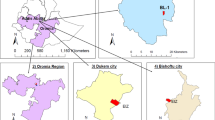Abstract
The aim of this paper is to present an approach to identify the main reasons behind the mismatch between objective and subjective quality of life (QoL) conditions that result in adaptation and dissonance. A mixed method approach was developed and applied in the sub-city of Mekelle, Ethiopia to measure objective and subjective QoL and to understand the divergence between the two. Focused group discussions, household surveys and walking interviews were the methods used for data collection and descriptive analysis, spatial analysis and content analysis were the methods of data analysis employed in this study. The results show that indicators such as ‘access to health facilities’ score a high level of objective QoL but low level of subjective QoL. Some citizens do not necessarily perceive their QoL condition in the same way as objective indicators do. By combining the subjective and objective QoL four states are identified: wellbeing, deprivation, adaptation and dissonance. Household’s strategies and priorities explain adaptation to inadequate objective QOL conditions. Some of the main reasons for adaptation and dissonance are related to issues of access to basic infrastructure, housing ownership, housing affordability, quality of services, and having additional means of income and survival strategies. Understanding the reasons identified for adaptation and dissonance can be used to provide better evidence for the formulation and implementation of public policies.



Similar content being viewed by others
Notes
Sirgy et al. (2006) refer to them respectively as real paradise, real hell, fool’s paradise, and fool’s hell.
The income poverty line for 2011 was of 2,508 birr (=146 USD).
References
Amer, S., Ottens, H. F. L., & de Jong, T. (2007). Towards spatial justice in urban health services planning: A spatial—analytic GIS—based approach using Dares Salaam Tanzania as a case study. Utrecht: Utrecht University.
BoFED (2011). Baseline Socioeconomic Survey Report of Tigray Region. Bureau of Finance and Economic Development (BoFED).
Bowling, A., & Windsor, J. (2001). Towards the good life: A population survey of dimensions of quality of life. Journal of Happiness Studies, 2(1), 55–82.
Costanza, R., Fisher, B., Ali, S., Beer, C., Bond, L., Boumans, R., et al. (2007). Quality of life: An approach integrating opportunities, human needs, and subjective well-being. Ecological Economics, 61(2–3), 267–276.
Craglia, M., Leontidou, L., Nuvolati, G., & Schweikart, J. (2004). Towards the development of quality of life indicators in the ‘digital’ city. Environment and Planning B-Planning & Design, 31(1), 51–64.
Cummins, R. (2000). Objective and subjective quality of life: An interactive model. Social Indicators Research, 52, 55–72.
Das, D. (2008). Urban quality of life: A case study of Guwahati. Social Indicators Research, 88(2), 297–310.
Eby, J., Kitchen, P., & Williams, A. (2012). Perceptions of quality life in hamilton’s neighbourhood hubs: A qualitative analysis. Social Indicators Research, 108(2), 299–315.
Evans, J., & Jones, P. (2011). The walking interview: Methodology, mobility and place. Applied Geography, 31(2), 849–858.
Foo, T. S. (2000). Subjective assessment of urban quality of life in Singapore (1997–1998). Habitat International, 24(1), 31–49.
Green, C., & Argue, T. (2011). Summary Guidelines and Standards for the Planning of Social Facilities and Recreational Spaces in Metropolitan Areas. Pretoria: CSIR.
Guihaire, V., & Hao, J.-K. (2008). Transit network design and scheduling: A global review. Transportation Research Part A: Policy and Practice, 42(10), 1251–1273.
Hsieh, H.-F., & Shannon, S. E. (2005). Three approaches to qualitative content analysis. Qualitative Health Research, 15(9), 1277–1288.
Hulchanski, J. D. (1995). The concept of housing affordability—6 contemporary uses of the housing expenditure-to-income ratio. Housing Studies, 10(4), 471–491.
McCrea, R., Shyy, T.-K., & Stimson, R. (2006). What is the strength of the link between objective and subjective indicators of urban quality of life? Applied Research in Quality of Life, 1(1), 79–96.
Mekelle City (2011). Final report of transport plan and implimentation strategy of Mekelle City. Development Partners.
Olson, G. I., & Schober, B. I. (1993). The satisfied poor. Social Indicators Research, 28(2), 173–193.
Pearl, D. C., Cabral, P., & Mateu, J. (2011). Mapping the quality of life experience in Alfama: A case study in Lisbon, Portugal. In B. Murgante, O. Gervasi, A. Iglesias, D. Taniar, & B. Apduhan (Eds.), Computational Science and Its Applications—ICCSA 2011 (pp. 269–283). Heidelberg: Springer.
Santos, L., Martins, I., & Brito, P. (2007). Measuring subjective quality of life: A survey to porto’s residents. Applied Research in Quality of Life, 2(1), 51–64.
Senlier, N., Yildiz, R., & Aktas, E. D. (2009). A perception survey for the evaluation of urban quality of life in Kocaeli and a comparison of the life satisfaction with the European cities. Social Indicators Research, 94(2), 213–226.
Shin, D. C., Rutkowski, C. P., & Park, C.-M. (2003). The quality of life in Korea: Comparative and dynamic perspectives. Social Indicators Research, 62–63(1), 3–16.
Sirgy, M. J. (2011). Theoretical perspectives guiding QOL indicator projects. Social Indicators Research, 103(1), 1–22.
Sirgy, M. J., Michalos, A. C., Ferriss, A. L., Easterlin, R. A., Patrick, D., & Pavot, W. (2006). The quality-of-life (QOL) research movement: Past, present, and future. Social Indicators Research, 76(3), 343–466.
Tesfazghi, E. S., Martínez, J. A., & Verplanke, J. J. (2010). Variability of quality of life at small scales : Addis Ababa, Kirkos Sub-city. Social Indicators Research, 98(1), 73–88.
UN-HABITAT. (2009). Urban Indicators Guidelines: Better Information, Better Cities. Monitoring the Habitat Agenda and the Millennium Development Goals-Slums Target. Nairobi: UN-HABITAT.
Veenhoven, R. (2002). Why social policy needs subjective indicators. Social Indicators Research, 58, 33–45.
Woldetinsaye, S. G. (2011). Analyzing variation of urban quality of life using participatory aproach in Addis Ababa, Ethiopia: A case study of Kirkos sub-city. Enschede: University of Twente Faculty of Geo-Information and Earth Observation ITC.
Author information
Authors and Affiliations
Corresponding author
Rights and permissions
About this article
Cite this article
Berhe, R.T., Martinez, J. & Verplanke, J. Adaptation and Dissonance in Quality of Life: A Case Study in Mekelle, Ethiopia. Soc Indic Res 118, 535–554 (2014). https://doi.org/10.1007/s11205-013-0448-y
Accepted:
Published:
Issue Date:
DOI: https://doi.org/10.1007/s11205-013-0448-y




